Reagan National Midair NTSB Hearing Day 3: Collision Avoidance & Safety Culture

On this episode of NTSB News Talk, Max Trescott covers the third and final day of the NTSB’s investigative hearing into the January 2024 midair collision near Washington’s Reagan National Airport between a PSA Airlines CRJ-700 and a U.S. Army UH-60L Black Hawk. Day 3 featured Panel 4: Collision Avoidance Technology and Panel 5: Safety Data and Safety Management Systems.
The hearing opened with spatial disorientation testimony and interviews with Army pilots about Route 4 altitude protections they incorrectly believed would keep them clear of Runway 33 arrivals. NASA’s Dr. Stephen Casner explained that cockpit traffic displays can help pilots spot targets up to eight times faster than by visual scan alone.
Experts detailed ADS-B system complexities — including the two incompatible broadcast frequencies (UAT and 1090ES) — and reviewed the limits of pre-ADS-B collision avoidance technology. The UH-60L Black Hawk lacks integrated traffic displays, relying instead on iPads with Stratus receivers, which Army policy prohibits the flying pilot from using. Portable ADS-B In devices provide only partial traffic pictures unless paired with ADS-B Out, limiting situational awareness.
Discussions turned to TCAS: its nuisance alert problem, differences for helicopter operations, and why the CRJ-700 lacks a certified ADS-B In solution. The NTSB Chairwoman confronted the FAA over its 17-year refusal to mandate ADS-B In, despite repeated post-collision recommendations. The Army is now procuring 1,685 Stratus/iPad sets for priority units, but operational use will still be limited at low level.
FAA data revealed 366 TCAS resolution advisories within 10 nm of DCA from 2023–2025. Testimony noted that crews involved in RAs are typically not notified unless a deviation occurs. Panelists debated safety culture, just culture, and leadership removals at DCA Tower after the accident. A controller supervisor described the pre-accident culture as “robust,” but post-accident changes removed key institutional knowledge.
The hearing also exposed gaps in PSA pilot special-qualification training for DCA — including no information on helicopter routes or operations — and examined simulator results showing that circling to Runway 33 can double or triple pilot workload compared to a straight-in to Runway 1.
Closing testimony on future ACAS XR technology indicated it could have alerted the Black Hawk crew 73 seconds before impact, with potential nationwide deployment by 2027. Max weaves these details into a narrative showing how technological shortfalls, flawed assumptions, procedural gaps, and cultural challenges all converged in this tragic midair — and what reforms could prevent a repeat.
NTSB Docket on Reagan National midair collision
Check out our other Aviation News Talk Network podcasts: